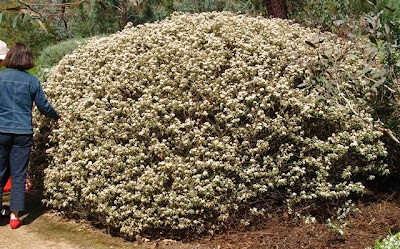Thickly hairy but quite beautiful, the Kerrawang
Time for an Australian plant, and some taxonomy. Back in late October I was enjoying the spectacular flowering of the Australian Garden at Royal Botanic Gardens Cranbourne. I was there at the tail end of sprinter (late September), and the place was by any assessment in full bloom. The wattles had finished and we were into the next 'spring' flush.
Now a warning, there is lots of plant nomenclature in this post. Just remember it's good for you....
One plant that stopped us in our tracks was Commersonia (previously Rulingia) dasyphylla, a member of the Malvaceae family, which also includes another of the knock-out plants in the Australian Garden, the Queensland Bottle Tree (Brachychiton rupestris). Both of these genera were included in the family Sterculiaceae not so long ago but the latest molecular sequencing supports them being rolled up with things like hibiscus. Ah, those botanists!
This specimen looks like it's been neatly pruned by one of our horticultural staff, or perhaps a local Swamp Wallaby. I don't think either is true but it's interesting to note that in its native habitat on the central and south coast of New South Wales, a close relative, Commersonia hermanniifolia, is nibbled by Rock Wallabies.
Commersonia now includes most of what we used to call Rulingia. Some taxonomic work by Barbara Whitlock and others, published in 2011, showed that the species of Rulingia and Commersonia are mixed up together in the evolutionary tree and that even though two distinct entities (genera) can be circumscribed, due to the rules of plant nomenclature the name Rulingia disappears from use. Our plant belongs to Commersonia rather than the new Androcalva.
I'm pretty sure this species is dasyphylla because I can see in my close up photo both hairy flowers and white staminodes (a sterile version of the male appendage, the stamina) curled over the top the anthers (bearing pollen). Although without fruit it is apparently difficult to separate this species from Commersonia rugosa and Commersonia breviseta.
Sadly I threw away the small fragment I collected before I could check the hairs on the undersurface of the leaf, another useful place to look for diagnostic features. In Commersonia dasyphylla the undersurface hairs are long, dense and star-shaped (with each of the arms of the star about equal in length) above a layer of smaller hairs. Indeed 'dasys' means thick with hair.
Interestingly, if you like this kind of thing, the species began life in 1810 as Commersonia dasyphylla, before moving across to Rulingia in 1826. It found its way back to Commersonia two hundred years after its first residency there.
The origin of its Aboriginal common name, Kerrawang, seems to be obscure. Other species of Commersonia also carry this name, with adjectives added such as dwarf and wrinkled. Our Kerrawang grows naturally from just south of the Victorian border (e.g. Mount Genoa) all the way up the east coast to Cairns, and Aboriginal communities in New South Wales at least have used the bark to make string.
There is an 1853 report from the Buffalo Range but it hasn't been found in any range or mountain in Victoria bearing this name since. Still, the species may depend on fire for regeneration so it's possible it may pop up in a few new places one day.
Just to show my day at Cranbourne was not all about the Kerrawang and its hairy relatives, this is just a little further up Eucalypt Walk.




Comments